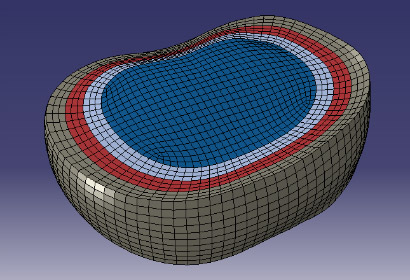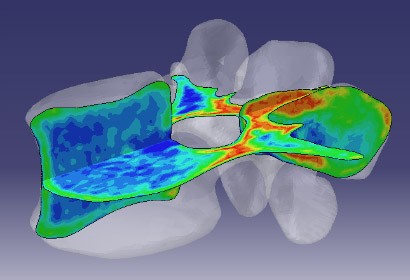
Projects
Various projects from the archive
Balloon kyphoplasty of the lumbar spine
A finite element study
Introduction: Vertebral compres sion fractures are one of the most common types of osteoporotic fractures (OF). In recent years percutaneous vertebroplasty and kyphoplasty have gained popularity in the treatment of OF. Vertebroplasty leads to significant pain reduction and improved function, but does not improve the kyphosis caused by the fracture. Kyphoplasty is a new technique designed to addres s this as sociated spinal malalignment. This procedure involves insertion and inflation of a balloon tamp into the damaged vertebra, followed by deflation and removal of the balloon and injection of bone cement into the resulting cavity.
The effects of vertebroplasty / kyphoplasty on the adjacent vertebral bodies and soft tis sues remains unclear. This study investigated such changes resulting from bipedicular kyphoplasty in the lumbar spine.
Methods: A 3-D finite element model of the lumbar spine (L2-L4) with corresponding vertebral bodies, facet joints, intevertebral discs and spinal ligaments was used to study the effects of bipedicular kyphoplasty under a compres sive load. Different cement volumes (15% and 30%), cement stiffnes ses (0.5, 1, 2 and 8 GPa) and bone qualities (healthy, osteopaenic and osteoporotic) were varied and the effects on bone strains, contact forces, ligament strains and disc nucleus pressures were examined.
Results: The results showed insignificant changes following cement augmentation of the L3 vertebra. This indicates that the effects on the adjacent vertebra and soft tis sues are small and therefore subsequent OF of the adjacent vertebra are unlikely to result from kyphoplasty. More significant changes may be attributed to a partial, not full, restoration of the kyphosis itself.





